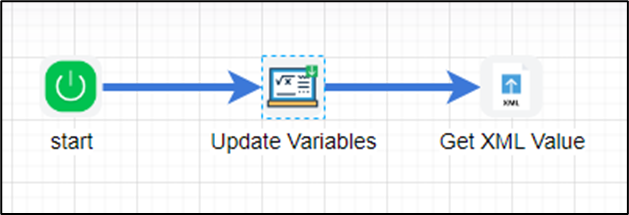getXMLNode Step
Description:
This step fetches a value from the selected XML node.
Returns
- xPath expression to query the selection - xPath value
- variable/global to store the value - node value
- node from the row to get the xml value from - node reference
- variable/global to store the collection index - loop value
- variable/global that holds the xml - XML value (and not the XML file path)
- maps XML node values to variables - map XML node values to variable/global
Inputs
- NextItem – returns this value if there are more items to return from the xml
- NoMoreItems – returns this if there are no more values to return from the xml
Usage:

Example:
Let’s build and execute the “getXMLValueDef” example.
- Create a new process definition called “getXMLValueDef” and open it in designer mode.
- Drag the “updateVariable, getXMLNode” step to the canvas.
- Connect the dots between the “Start” step and other steps, as shown above.
- Define variables or globals to store the XML Value and the result.
- Click the "updateVariable" step to configure its "Required" properties. Provide a name for the step. Click the Save button. Note: Click the "AI Predict" button for the Copilot to add new process steps that match your process description.

- Click the "updateVariable" step to configure its "Optional" properties. Provide a variable or global reference to hold the XML value. Select “Yes” for the “Has Expression” field. Click the Save button.

- The “Logging” setting configuration is necessary for documentation and also measures the workflow progress and the percent complete. This is achieved by configuring the step state and percent fields individually, as shown in the images below. Configure the “Logging” using the following properties.

- Click the "getXMLNode" step to configure its "Required" properties. Provide a name for the step. Provide the XPath expression to query the collection. Provide a variable or global to store the node value. Provide the node value from the row from which to get the value. Provide a variable or global reference to store the collection index. Provide the variable or global reference that holds the XML value. Click the Save button. Note: Click the "AI Predict" button for the Copilot to add new process steps that match your process description.

- Click the "getXMLNode" step to configure its "Optional" properties. Click the button to map XML node values to variables. A pop-up window is displayed for configuration. Click the Add Row button to insert an empty row. Provide the XML node and variable value. Click the Save button. You may add multiple XML nodes and values using the Add Row button.

- The “Logging” setting configuration is necessary for documentation and also measures the workflow progress and the percent complete. This is achieved by configuring the step state and percent fields individually, as shown in the images below. Configure the “Logging” using the following properties.

- The XML value used in this example is included below.
<root> <Book1> <MaterialID>123456789</MaterialID> <MaterialName>Roman Test</MaterialName> <Quantity>123.6</Quantity> <UoM>Kg</UoM> <Tolerance>2</Tolerance> </Book1> <Book1> <MaterialID>123456790</MaterialID> <MaterialName>Roman Test 2</MaterialName> <Quantity>133.6</Quantity> <UoM>Kg</UoM> <Tolerance>3</Tolerance> </Book1> <Book1> <MaterialID>123456791</MaterialID> <MaterialName>Roman Test</MaterialName> <Quantity>143.6</Quantity> <UoM>Kg</UoM> <Tolerance>4</Tolerance> </Book1> <Book1> <MaterialID>123456792</MaterialID> <MaterialName>Roman Test 3</MaterialName> <Quantity>153.6</Quantity> <UoM>Kg</UoM> <Tolerance>5</Tolerance> </Book1> <Book1> <MaterialID>123456793</MaterialID> <MaterialName>Roman Test</MaterialName> <Quantity>163.6</Quantity> <UoM>Kg</UoM> <Tolerance>6</Tolerance> </Book1> </root>
- Save the process definition, create a new instance, and then execute it. Render the process instance. Click the process step. The step should get the details of the XML node value and store them in the output variable. Select the process instance to render.

- Click on the GetXMLValue step to view the instance properties.

Definition Sample:
You may download the sample definition(s) from the link here and later import them (drag-and-drop) to your FlowWright Process Definition (XML file) or Form Definition (HTML file) page.
Note: Please verify and complete the process steps for any missing configurations, such as file path references and database connections, after import. Then, save the definition to confirm the changes.
Click here to download the sample file.